

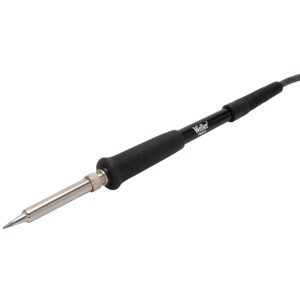
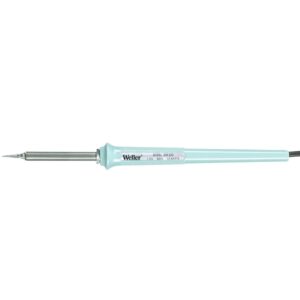
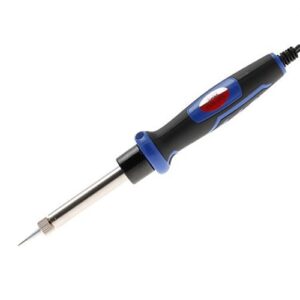
Choose the Best Fine Tip Soldering Irons
[modalsurvey id=”118557266″ style=”flat”]Customer’s Choice: the Best Rated Fine Tip Soldering Irons
[survey_answers id=”118557266″ style=”plain” data=”score”] users answered this survey. Please help us improve this review!
[survey_answers id=”118557266″ style=”piechart” legend=”true”]
Soldering iron tips come in a variety of shapes and sizes. You don’t have to worry about this, but it is something that beginners should keep in mind when they are looking for one. Because the picked type will depend on what exactly you need them for. The most common thing people choose is fine tip irons that are perfect if you’re going to be soldering close together or want great detail with your work.
However, there are others such as wide chisel tips that allow a greater distance between solder points so more can fit and ball-shaped pointed ones suitable for larger distances. They all vary from each other like crazy so it’s important to consider what situation fits best before making any purchase.
What is the best fine tip soldering iron? Do you need to use a higher wattage for larger jobs? What about temperature control? These are all important questions that the experts will be answering in this guide. Some of the best fine tip soldering irons on the market will be reviewed along with the tips to help you make a reasonable purchase.
GLE2016 Soldering Iron Kit 60W with 5 Different Tips – the Editor’s choice!
 The GLE2016 Electric Soldering Iron Kit comes with a 60-watt heated core and five different tips for working on different materials. The quality construction means it resists breaking, but beginners are better suited to work with something else.
The GLE2016 Electric Soldering Iron Kit comes with a 60-watt heated core and five different tips for working on different materials. The quality construction means it resists breaking, but beginners are better suited to work with something else.
It’s made of stainless steel and iron plate so that your needs are met whether you need to handle delicate or heavy materials, but its rubber non-slip grip feels cheap in comparison to other products available out there. This can be ideal for the newcomer than the professional.
Choose from five different tips and stylish color options with our real silicone grip heat shield and steady flow of power at up to 650°F (347°C). It heats up fast and doesn’t take long to reach its peak temperature – it also operates at 600-1000 watts! With so much professional input into the design process that happens before it gets delivered into your home, we guarantee reliability.
Pros
- Made with stainless steel and iron-plated tip;
- Reliable and stable;
- Ceramic heater core;
- Heats up quickly;
- 5 pieces are included;
- Non-slip handle;
- Easy to use;
Cons
- Only for small and medium projects;
- Average build quality;
- Adjusting the temperature is difficult;
There’s something for every DIYer in this 60-watt soldering iron set! Whether you need a versatile tool for your projects, or just want to upgrade from a cool design without compromising on quality, this is the kit for you.
Delcast 30 Watt Precision Tip Soldering Iron – the best for small projects!
 The Delcast 30-Watt Precision Soldering Iron is an affordable and very basic model. You can use this tool to take on minor soldering tasks, but if you want something that will last for a long time and offer better quality in your electronics projects, consider more expensive options.
The Delcast 30-Watt Precision Soldering Iron is an affordable and very basic model. You can use this tool to take on minor soldering tasks, but if you want something that will last for a long time and offer better quality in your electronics projects, consider more expensive options.
If you’re looking for something more powerful or need something that regulates its temperature, this Delcast 30 Watt Precision Tip Soldering Iron does what it needs to do with some extra added perks such as an adjustable angle handle and ceramic heating element.
It’s powerful enough to tin well-connected surfaces on boards and components without damaging the copper traces while breaking.
Pros
- Good wattage;
- Lifetime warranty;
- Great for electronics soldering;
- Affordable;
Cons
- Only for light-duty jobs;
- Average quality;
Getting this little soldering iron kit is ideal if you’re on a budget and want to do minor adjustments/fixes. However, it does the job and heats up in 30 seconds or less. As long as you’re not going into electronics work with this average-quality soldering iron, there won’t be any problems.
Weller PES51 50-Watt Soldering Pencil – the best for the temperature range!
 The Weller PES51 is perfect for soldering projects and works on a fairly broad range of temperatures. Good safety features are also included, making this a must-have tool to keep around the woodshop.
The Weller PES51 is perfect for soldering projects and works on a fairly broad range of temperatures. Good safety features are also included, making this a must-have tool to keep around the woodshop.
The slim design provides less fatigue than other pen-annular or cylindrical-style models. Also, it’s fitted with a thread of non-burnable silicone rubber cord for safety that lasts up to a decade! This handsome devil works in temps from 350 degrees Fahrenheit all the way up to 850 degrees Fahrenheit – meaning no matter what project you have in mind this device will do the job.
Pros
- Great temperature range;
- Great wattage;
- 7-year warranty;
- Durable;
- Efficient;
- Good performance;
Cons
- Expensive;
- No extra tips;
The Weller PES51 Soldering Pencil is the perfect companion for your WES51 soldering station. The slim, compact design and non-burnable cord help you get your project done in safety and comfort. Plus, at 50W it should do the trick no matter what hobby or profession you’re into!
Weller WM120 Pencil Thin Soldering Iron – the best for delicate materials!
 This Weller WM120 soldering pencil is a great option for people who want reliability but not power. It has a low power rating and still offers up to 1 hour of usage, with an 800-degree maximum temperature that can be controlled by the wheel at the back of the pen.
This Weller WM120 soldering pencil is a great option for people who want reliability but not power. It has a low power rating and still offers up to 1 hour of usage, with an 800-degree maximum temperature that can be controlled by the wheel at the back of the pen.
Not your ideal high-powered soldering tool, this pencil is perfect for light repairs or making quick corrections on scale models so they look their part! Also, this Weller WM120 soldering pencil is safe for use with delicate materials.
However, unlike other soldering pencils on this listicle, it does not offer as much power with its 12-watt output. Nevertheless, you’ll be able to save money and energy because the higher wattages typically mean that they eat through electricity faster than lower watt rated counterparts.
Pros
- For delicate materials;
- Great temperature limit;
- Recommended by experts;
- Lower power consumption;
- Budget-friendly;
Cons
- Limited warranty;
- Not powerful;
- Only fixed temperature;
This soldering pencil leaves a smooth finish. The eighth-inch soldering tip can heat up to 800 degrees Fahrenheit, giving you enough wait to solder without burning yourself. It has a long-lasting warranty and only needs 12 watts of power per hour, so it’s easy on the environment too.
Aven 17521 40W Soldering Iron with Fine Tip – the best for heavy-duty jobs!
 This corded soldering iron is perfect for crafty and professional electronics work alike. The 40 watt, 900 degree Fahrenheit temperature range coupled with the long-life replaceable fine tip gives you unmatched versatility when it comes to your circuitry projects.
This corded soldering iron is perfect for crafty and professional electronics work alike. The 40 watt, 900 degree Fahrenheit temperature range coupled with the long-life replaceable fine tip gives you unmatched versatility when it comes to your circuitry projects.
This soft-grip handle is ergonomically engineered to help loosen your hand after extended use, making this an investment that will serve you well for years to come!
Pros
- Long cord (5 feet);
- Soft and round grip;
- Durable;
- Long-life tips are replaceable;
- Good for general purpose DIY projects;
Cons
- Limited portability;
- Heats up dangerously hot;
The sharp, bright flame of the Avent 17521 Soldering Iron is a sign your project can’t be stopped. The cord reaches up to 5 feet and keeps you from being chained down with pesky cords while welding, opting in for an RF remote control instead!
The Buyer’s Guide
Types of Fine Tip Soldering Irons
There are 3 types of fine tip soldering irons. They all have differences in price, size and capabilities. Let’s take a look at those differences:
- The most basic type is the fine point iron that typically comes with thin tips for delicate work as well as some other features like smaller handles or small weights to attach to the end for better control during use that can be difficult when using just your hands. This tool has been around for decades and still remains popular today because it is affordable (usually priced below $20) but also sturdy enough to last many years if used correctly so they make excellent starter tools before investing in more expensive options;
- The next thing is a pencil iron. This is an excellent choice for beginners that need tools with precise tips and heftier handles because they are designed specifically for soldering thicker material;
- For more experienced users, the next option would be something called a pointer iron which has long slim handles and small rounded tips that are perfect for detail work on circuit boards (PCBs) or other delicate materials where you don’t want to risk damaging anything. The downside of this type though can be its weight, often weighing up to four times what an average pencil point does. Therefore, it takes some getting used to before fully mastering these types of irons with fine tips;
Things to Consider When Buying Fine Tip Soldering Irons
The best choice is the one that works for you. The most important thing to remember when selecting fine tip soldering irons is your work environment. Consider how often you will be working with small pieces of equipment, and if there are any safety hazards or issues involved in said environment. If this information can’t be determined ahead of time then consider looking into reviews from people who have used these products before doing so yourself.
Ask yourself – why do you need a fine tip soldering iron? For some projects, using a precision tool may not make sense but could instead just offer more frustration than necessary; others might dictate their use by necessity based on task needs rather than personal preference alone. In either case, taking care to think through the needed usage ahead of time can help cut down on potential frustrations and ensure that you are investing in a tool best suited to your needs.
Consider what type of work will be done with the soldering iron itself, as well if there is any specific need for precision such as electronics or other delicate projects. For example, some fine point tools offer wider tips that may function better when working with larger pieces while others might come equipped with specially shaped points like ballpoints designed for intricate tasks.
When considering wattage output it’s important to note that higher outputs often correlate to greater heat production. This means faster heating times but also an increased risk of burning nearby objects or causing fires so caution should always be taken around flammable materials.
Heat selection is another thing to consider when working with any fine point iron; the wrong heat setting can not only lead to a badly soldered connection but also possible damage (sometimes irreversible) to sensitive electronics like those found in computers or other small gadgets.
Lastly, it’s important to know what type of tips are used on your iron because switching between solder and flux will require different tools for each job – again this varies from one model of irons so make sure you’re aware of what you’ll need before starting a particular project. Tiny tips are better for detailed work and precise soldering.
You need to make sure you have the right voltage that matches your country’s standards (110 or 220V). If you use a soldering iron often, it is worth investing in one with replaceable heating elements and interchangeable tips with auto shutoff function. This will save battery life if you’re using cordless irons.
Soldering irons with a retractable cord are ideal for when you want to work on something small. -There is also the option of choosing an adjustable soldering iron, which has interchangeable tips that can be changed depending on what type of solder joints you need to use.
Fine tipped soldering irons may also come with useful extra features such as adjustable power settings, temperature adjustability or interchangeable tips to accommodate different projects.
How Does a Fine Tip Soldering Iron Work?
Fine tip soldering irons are special tools for electronics. The process of using a fine tip soldering iron resembles the way we apply nail polish to our nails, or how one would use an ink pen on paper. Just like other types of soldering equipment, this type of tool is used when assembling electronic circuit boards and components that cannot be easily reached with regular solder guns. The solder needs to be melted by preheating it before applying it over two metal pieces in order to create a bond between them.
This will allow both parts to stay together and not come apart through the power supply’s electrical current flow that is often referred to as “electrical conduction”. A lot of surface area needs to be heated at once so they are melted together. This is why a fine point soldering iron tip is used because it can heat up and melt the solder at the same time on both sides of an object.
The size of this type of tool makes it easy to pre-heat more surfaces in less time than using regular-sized tips that are much wider. Their smaller distance from one surface to another means that they can deliver enough heat through their small contact points for better performance without having to keep drawing back and forth across the joint or circuit board while heating metal parts with larger tool types such as irons and guns with wide tips.
Plus, when doing any high-quality work like assembling circuit boards with gold or silver soldering, they are the ideal tool to use because their fine points allow for much more control and accuracy.
Safety When Using a Fine Tip Soldering Iron
Safety is a major concern when using soldering irons. For safety, always use the proper type of iron that matches your project’s needs, and follow all manufacturer guidelines for usage.
If not handled with care, these tools can be dangerous for your health. In order to avoid injury or burns from accidental contact with heat elements of solder and flux, it is important that all safety precautions are taken into consideration before operating a soldering iron.
Invest in a tool with an insulated handle, which will help to protect your fingers from the heat generated by the tool. These tools typically cost more than other types of irons and are made for finer work that needs close attention and precise handling.
When using a hot iron on delicate pieces of material like fabric, first use a damp sponge to cool off the area before you start working on it so as not to cause any damage. Always maintain proper ventilation when working near gas sources or providing some sort of fuel source for your project. This is especially important for soldering irons.
The safety tips you should follow when soldering:
- Wear gloves made out of fabric or silicone rubber;
- Make sure that nothing else such as clothing items come into close contact with heated components (metal parts) while working;
- Remove any metal jewelry prior to handling the equipment;
- Never touch the tip of a soldering iron or any other hot surface;
- Plug in the power cord to an outlet that has been verified as grounded and make sure you’re using it indoors;
- Do not back out heated components (metal parts) from your circuit board while they are still plugged into an electric socket. Allow them to cool before removing for safety reasons;
- Wear goggles with dark lenses – any light hitting the surface of the hot solder will reflect up into your face and potentially damage your soldering iron;
How to Solder Using a Fine Tip Soldering Iron?
The process of soldering is a relatively simple one. Begin by melting solder onto your workpiece, then hold the iron to it and feed in additional solder until there is enough on either side of the joint for good electrical contact (you will usually see small beads on both sides).
Remove the heat from the area while continuing to feed more solder into it with your fine tip soldering iron – be careful not to use too much! Once you have done so, remove any excess flux or dirt that might interfere with the proper connection. Finally, trim away excess wire using an appropriate cutting tool before connecting.
FAQ
How to replace a soldering iron tip?
Replacing a soldering iron tip is not as difficult as it sounds. The first step is to remove the old tip and replace it with a new one. You should make sure your soldering iron is turned off at this point. Next, scrape or peel away any solder that may be sticking onto the surface of your device using an end of the wire from another part of the component.
This will help loosen up any residual solder so that when you pull on the tool there won’t be any leftover pieces behind after removing it completely from its socket. Now simply slide the replacement head into place and turn it back on again to resume use.
How to tell if a soldering iron tip is bad?
To tell if a soldering iron tip is bad, you have to determine how often it’s used. If the user only uses them occasionally and these tips are not dirty or corroded, then there is no need for replacement. However, if they use their soldering irons more than once a week and the tips become really rusty after just one usage – it’s time to replace them.
For example, when people use solder that is lead-free, it often gets really hot, which can cause the solder to get old and corrode. Corrosion buildup will shorten the life of your tool. With large diameter wire gauges, the heat from the soldering iron is better distributed and it takes a lot longer for the solder to oxidize.
How to clean a soldering iron tip?
There are a few ways you can clean your soldering irons. One is to use sandpaper to scrape off the oxidization from the tip of your iron.
Another way is to cut a piece of copper wire, bend it into a loop and place that over the tip while heating the solder on top until all impurities have been removed. Afterward, when you turn off your power switch then wipe away any residue with some cloth or cotton swabs dipped in alcohol or acetone.
The third way would be by using an abrasive pad such as those used for dishes, which will gently remove contamination without damaging delicate surface features (unless they’re very rough). You should also blow out old dust and dirt particles from the tip, which can have an adverse effect on heat conduction.
Are cheap soldering irons any good?
Cheap soldering irons are not going to last you very long and they will also be more difficult to use. It is recommended that if you want a product for the occasional time, then go with a cheap one. However, if this will be something used on an everyday basis or at all times then it would be best to invest in a better quality iron because there is nothing worse than having your project fall apart because of bad tools!
Is a soldering gun better than a soldering iron?
Soldering guns are great for large tasks, like when you need to solder a lot of wire. A soldering iron is perfect for precision work, but it won’t have the power needed to work with larger projects. The best choice will depend on what you’re working on and your skill level: if you already know how to use one well then an iron might be better; if not then try a gun first before using something more complicated!
What are the disadvantages of soldering?
There are a few drawbacks to consider:
- Soldering requires the use of a soldering iron that can be quite expensive;
- Flux is used to remove oxides from an area being worked on by removing them through capillary action and wetting surfaces so that solder can flow freely into joints. Flux creates fire hazards, toxic fumes, and corrosive residues which must be cleaned up afterward;
- The process of thinning (covering the exposed metal with molten solder) may leave the flux residue behind if not done correctly. Solder is very liquid – it will seep past crack points in materials you are trying to join together unless they are completely sealed together beforehand – and it contains lead as well as other health risks like cadmium;
- Solder cannot usually fill gaps greater than 0.01 inches wide;
Can you solder without flux?
Yes, you can solder without flux. However, it is not suggested that you do so because the resulting bond may be weaker than if flux was used. The best fine tip soldering irons require either rosin or acid-based flux when soldering to ensure a strong and reliable joint.
Can I use a fine tip soldering iron for jewelry?
Yes. Fine tip soldering irons are perfect for jewelry because most have a smaller head that can reach tighter and more intricate spaces. If you need to solder jump rings, fine tips will make the process much easier than with larger heads.
Video Tutorial: Weller WLC100 40-Watt Soldering Station
Final thoughts
If you’re looking for a new soldering iron, don’t worry! In this guide, there are the tips and tricks to help you find the best fine tip soldering irons on the market today. Some of these models include temperature control so that you can get more precise as well as higher wattage options if necessary for larger jobs.

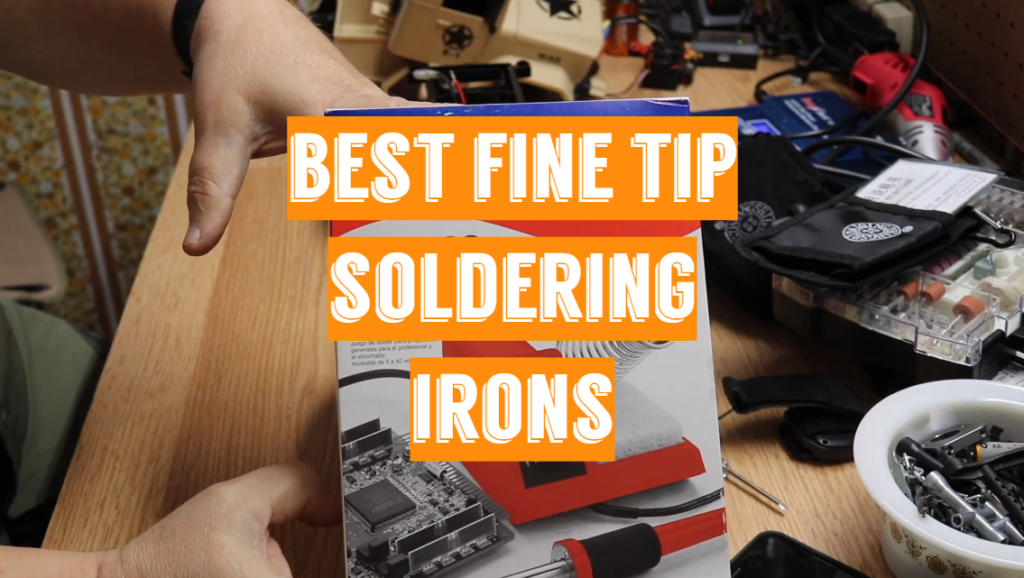
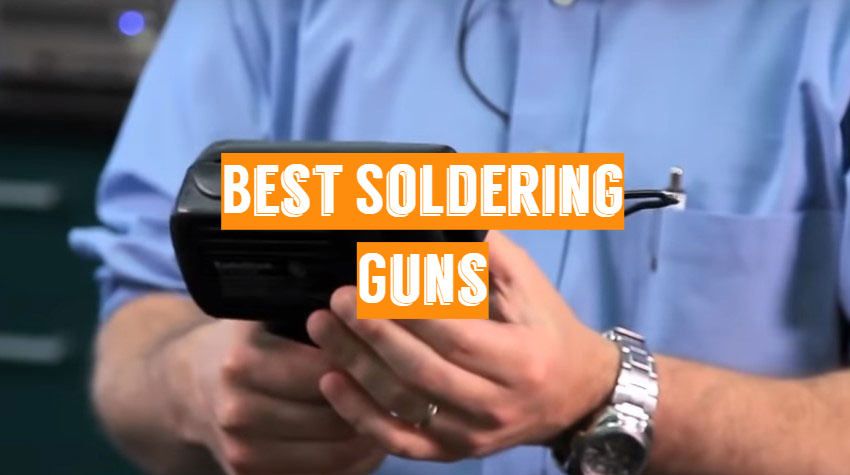
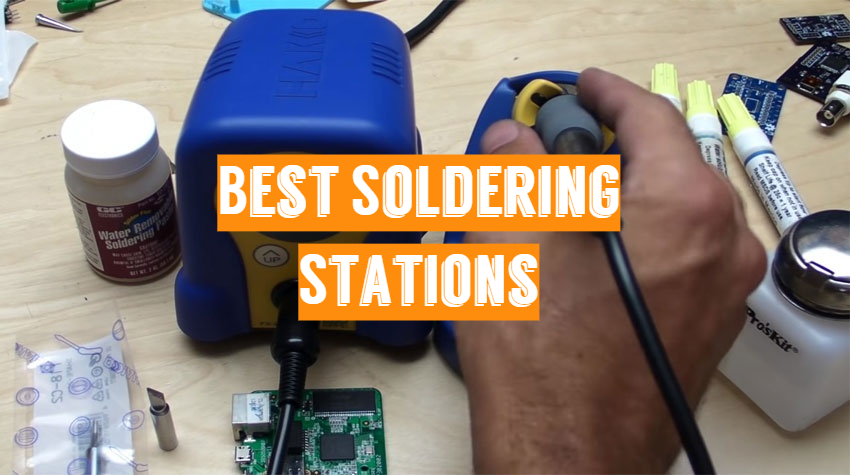
I have been doing soldering work for over 20 years. I had never used the fine tip soldering irons before, but I knew that they were supposed to be excellent because of all the reviews. When I saw this product on sale online, I decided to get it and give it a try. It came with everything you need: Soldering Iron Stand, Anti-static Mat, Cleaning Brush, and Sponge Tip Cleaner Tool Kit in a nice carrying case that’s easy to take on the go or store away when not in use! The stand is great because it also has an adjustable height so you can set your iron in just the correct position for all your needs!